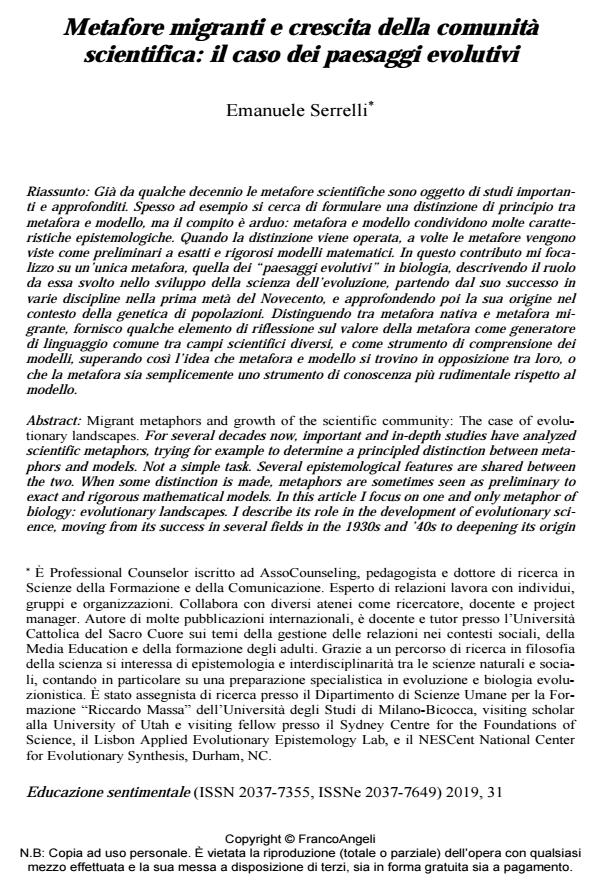Metafore migranti e crescita della comunità scientifica: il caso dei paesaggi evolutivi
Titolo Rivista EDUCAZIONE SENTIMENTALE
Autori/Curatori Emanuele Serrelli
Anno di pubblicazione 2019 Fascicolo 2019/31
Lingua Italiano Numero pagine 14 P. 115-128 Dimensione file 206 KB
DOI 10.3280/EDS2019-031010
Il DOI è il codice a barre della proprietà intellettuale: per saperne di più
clicca qui
Qui sotto puoi vedere in anteprima la prima pagina di questo articolo.
Se questo articolo ti interessa, lo puoi acquistare (e scaricare in formato pdf) seguendo le facili indicazioni per acquistare il download credit. Acquista Download Credits per scaricare questo Articolo in formato PDF

FrancoAngeli è membro della Publishers International Linking Association, Inc (PILA)associazione indipendente e non profit per facilitare (attraverso i servizi tecnologici implementati da CrossRef.org) l’accesso degli studiosi ai contenuti digitali nelle pubblicazioni professionali e scientifiche
Già da qualche decennio le metafore scientifiche sono oggetto di studi importanti e approfon-diti. Spesso ad esempio si cerca di formulare una distinzione di principio tra metafora e mo-dello, ma il compito è arduo: metafora e modello condividono molte caratteristiche epistemo-logiche. Quando la distinzione viene operata, a volte le metafore vengono viste come prelimi-nari a esatti e rigorosi modelli matematici. In questo contributo mi focalizzo su un’unica me-tafora, quella dei "paesaggi evolutivi" in biologia, descrivendo il ruolo da essa svolto nello sviluppo della scienza dell’evoluzione, partendo dal suo successo in varie discipline nella prima metà del Novecento, e approfondendo poi la sua origine nel contesto della genetica di popolazioni. Distinguendo tra metafora nativa e metafora migrante, fornisco qualche elemen-to di riflessione sul valore della metafora come generatore di linguaggio comune tra campi scientifici diversi, e come strumento di comprensione dei modelli, superando così l’idea che metafora e modello si trovino in opposizione tra loro, o che la metafora sia semplicemente uno strumento di conoscenza più rudimentale rispetto al modello.
Parole chiave:Modello, metafora, linguaggio scientifico, evoluzione, paesaggio adattativo.
Emanuele Serrelli, Metafore migranti e crescita della comunità scientifica: il caso dei paesaggi evolutivi in "EDUCAZIONE SENTIMENTALE" 31/2019, pp 115-128, DOI: 10.3280/EDS2019-031010